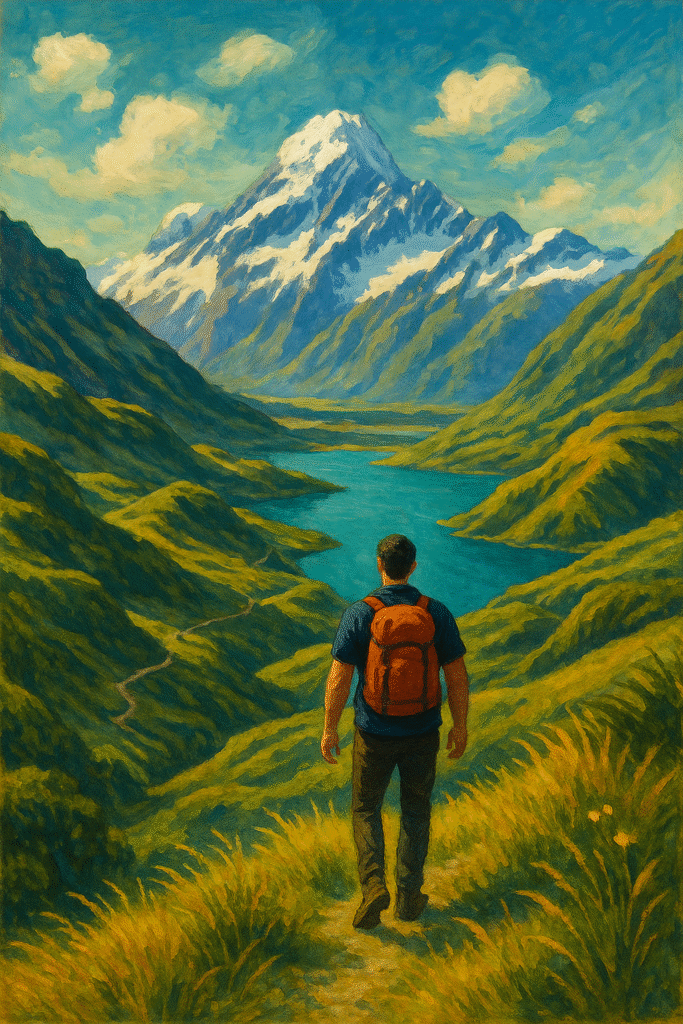Table of Contents
Introduction to New Zealand’s Natural Wonders
New Zealand, a remarkable archipelago located in the southwestern Pacific Ocean, is renowned for its breathtaking natural landscapes and unique ecosystems. Comprising two main landmasses, the North Island and the South Island, as well as numerous smaller islands, New Zealand boasts a diverse geography that ranges from rugged mountains to serene beaches. This geographical diversity supports an exceptional variety of flora and fauna, contributing to New Zealand’s reputation as a haven for nature enthusiasts and adventurers alike.

The country’s ecosystems are intricately woven together, characterized by ancient forests, pristine lakes, and cascading waterfalls. The Southern Alps serve as a majestic backbone to the South Island, while the North Island is home to geothermal wonders and lush rainforests. Each of these environments harbors unique plant and animal species, many of which are endemic to New Zealand. Notable examples include the Kiwi bird, a national icon, and the distinctive Kauri tree, both of which exemplify the unique natural heritage of this remarkable nation.
Moreover, the cultural significance of nature in New Zealand is deeply rooted in the traditions and beliefs of the Māori people, who regard the land as a living entity, imbued with spiritual significance. The concept of “Whakapapa” emphasizes the connection between all living things and the environment, highlighting the importance of conservation and respect for nature. This rich cultural perspective invites visitors to engage with the landscape beyond mere observation, fostering a deeper appreciation for New Zealand’s natural gems.
As we explore the lesser-known yet breathtaking locations in New Zealand, including stunning waterfalls and enchanting glowworm caves, the intricate relationship between the land and its inhabitants becomes abundantly clear. Such hidden wonders contribute to the allure of New Zealand’s natural wonders, offering unforgettable experiences for those who seek to immerse themselves in this captivating environment.
The Allure of Waterfalls in New Zealand
New Zealand is renowned for its stunning natural landscapes, and its waterfalls are among the most breathtaking features that draw visitors from around the globe. The country is home to an impressive variety of waterfalls, each showcasing unique characteristics that contribute to their allure. From towering cascades to serene streams, these natural wonders offer a glimpse into the scenic beauty that New Zealand has to offer.
One of the most iconic waterfalls is Huka Falls, located near Lake Taupo. This powerful waterfall is distinguished by its vivid turquoise water that surges through a narrow gorge, creating a mesmerizing display of nature’s force. Visitors can enjoy spectacular viewpoints along the trails, where they can capture stunning photographs of the rushing water. The vibrant color of the water is due to its mineral content, which adds to the unique charm of Huka Falls.
Another remarkable waterfall is Sutherland Falls, often considered the tallest in New Zealand. Nestled in the Fiordland National Park, this majestic waterfall drops a staggering 580 meters in a series of cascades. The journey to reach Sutherland Falls includes a scenic hike through lush rainforests, providing opportunities for birdwatching and appreciating the diverse flora. The best time to visit is often during the spring melt, when the waterfall is at its fullest, offering a spectacular sight.
While popular waterfalls attract many visitors, New Zealand also harbors hidden gems waiting to be discovered. For example, the lesser-known Bridal Veil Falls in the Waikato region presents a tranquil setting with multiple viewing platforms that allow for picturesque photographs. Visitors seeking off-the-beaten-path experiences can also explore the remote Te Taru Falls located in the Nelson region, where the sound of cascading water creates a serene atmosphere far removed from the hustle and bustle of tourist hotspots.
Exploring the Lesser-Known Waterfalls
New Zealand is renowned for its breathtaking natural beauty, and among its treasures are a multitude of spectacular yet lesser-known waterfalls that often do not receive the recognition they deserve. These hidden gems invite adventurous travelers to explore their serene surroundings while enjoying the lush landscapes that characterize this stunning country.
One such waterfall is Whangarei Falls, located a short drive from Whangarei City. This enchanting waterfall drops approximately 26 meters, plunging into a tranquil pool surrounded by a verdant reserve. The track to reach Whangarei Falls is quite easy, making it accessible for families and casual hikers alike. The path offers scenic views and the chance to spot native birds, immersing visitors in the rich biodiversity of the region.
Another gem worth seeking out is Bridal Veil Falls, situated in the Waikato region. This majestic waterfall, with its nearly 55-meter drop, is particularly captivating, especially after rainfall when it flows vigorously. The journey to Bridal Veil Falls involves a short walk of around 600 meters from the car park, with a combination of stairs and well-maintained paths leading to stunning viewpoints. The echoing sound of the cascading water and surrounding native flora creates a serene atmosphere, perfect for nature enthusiasts and photographers alike.
While these waterfalls may be lesser-known, they certainly possess unique charm and offer visitors a chance to experience New Zealand’s natural beauty away from the more crowded tourist spots. Whether one seeks a peaceful retreat or an opportunity to explore the local environment, Whangarei Falls and Bridal Veil Falls serve as inviting destinations that fulfill the desire for adventure and tranquility.
The Fascination with Glowworms
Glowworms, scientifically known as Arachnocampa luminosa, are enchanting bioluminescent insects indigenous to New Zealand. These remarkable creatures, which are actually the larvae of a type of gnat, emit a stunning blue-green light, creating a magical ambiance in the dark caves and forests where they reside. Their captivating glow is not merely a spectacle; it serves a vital role in their survival strategy. The light attracts unsuspecting prey, typically small insects, which become ensnared in the silk threads that the glowworm secretes.
The lifecycle of a glowworm is fascinating and spans several months. After mating, female glowworms lay eggs that hatch into larvae. For six to twelve months, these larvae exist in a state of darkness, growing steadily while producing their ethereal glow. During this time, they develop a complex network of silk threads used to capture food. Once fully mature, the larvae pupate, ultimately emerging as adult midges, which are short-lived and lack functioning mouthparts, dedicating their existence solely to reproduction. This adaptation is an example of nature’s intricacies and the balance within ecosystems, showcasing glowworms’ role as both predator and prey.
The experience of witnessing glowworms in their natural setting is often described as otherworldly. Visitors navigating through New Zealand’s treasured caves, such as the Waitomo Caves, find themselves in a starlit environment, with thousands of glowworms illuminating the rocky surfaces above. This spectacle not only mesmerizes onlookers but also emphasizes the importance of these creatures in maintaining the ecological balance. Glowworms offer a unique contribution to New Zealand’s biodiversity and serve as a reminder of the delicate interconnectedness of life forms in nature’s wondrous tapestry.
Top Glowworm Caves to Visit
New Zealand is renowned for its breathtaking landscapes and unique natural wonders, among which glowworm caves hold a special place. Visitors eager to experience these enchanting luminescent displays should consider two primary locations: the Waitomo Caves and the lesser-known Te Anau Glowworm Caves. Both destinations provide an opportunity to witness the captivating beauty of glowworms, creating an ethereal atmosphere that transports visitors into a world of wonder.
The Waitomo Caves are perhaps the most famous glowworm-dominated site in New Zealand. Located on the North Island, this vast network of limestone caves attracts thousands of tourists each year. Visitors can embark on guided tours that include boat rides along the underground river, where the glowworms illuminate the cave ceilings akin to a starry night sky. The ideal time to visit Waitomo Caves is during the warmer months, from November to April, when glowworm activity is at its peak. These tours not only highlight the spectacular glowworms but also the unique geological formations present throughout the caves.
On the South Island, the Te Anau Glowworm Caves offer a more serene alternative to their North Island counterpart. Located near the stunning Fiordland National Park, this hidden gem features a mystical underground river. Visitors can join guided tours that provide insight into the features of both the caves and the biology of the glowworms. The best time for sightseeing in the Te Anau Glowworm Caves is also during the warmer months, generally from late spring through to autumn, allowing guests to enjoy the diverse flora and fauna in the surrounding area.
Whether one decides to explore the renowned Waitomo Caves or opt for the peacefulness of Te Anau, each location promises an unforgettable experience in one of New Zealand’s most enchanting natural treasures.
Ecological Significance of Waterfalls and Glowworms
Waterfalls are not merely breathtaking natural formations; they play a vital ecological role within their ecosystems. The flow of water cascading over cliffs creates diverse microhabitats, fostering unique biological communities. The constant movement of water helps maintain oxygen levels, supporting aquatic life such as fish and invertebrates. Additionally, waterfalls contribute to sediment transport, which is essential for nutrient distribution across the ecosystem, promoting the growth of various plant species along riverbanks.
Glowworms, on the other hand, are emblematic of the intricate ecological balance found in New Zealand’s caves and forested regions. As larvae of the species Lamprima adelaide, glowworms use bioluminescence to attract prey, notably small insects. This predatory behavior illustrates their role as both prey and predator within the food web. By attracting invertebrates, glowworms not only sustain themselves but also regulate insect populations, demonstrating their significance in maintaining ecological stability.
The interconnectedness of species in these ecosystems is critical. Waterfalls often serve as natural barriers, influencing species distribution by isolating populations and thereby promoting biodiversity. The unique habitats formed by the splashing water and moist environments encourage specialized plant growth, which in turn supports a variety of animal species. Conversely, the presence of glowworms can indicate healthy cave ecosystems, as their survival relies on a well-balanced habitat rich in moisture and food sources.
However, the increasing popularity of these natural wonders can pose a threat to their fragile ecosystems. Responsible tourism practices are essential to preserve the habitats of waterfalls and glowworms. Tourists contribute to the local economy, but if not managed correctly, they can lead to habitat degradation and water pollution. Ensuring that visitors are educated about the ecological significance of these sites is crucial in promoting sustainable tourism, thereby protecting these hidden gems of New Zealand’s natural heritage for future generations.
Tips for Responsible Nature Exploration
Exploring the breathtaking natural wonders of New Zealand is a thrilling experience, yet it comes with the responsibility to protect these pristine environments. Responsible nature exploration ensures that the beauty of the surroundings is preserved for future generations to enjoy. One effective way to minimize your impact is to adopt the Leave No Trace principles. These guidelines advocate for leaving nature as you found it, encouraging visitors to avoid disturbing wildlife, removing litter, and refraining from picking plants or flowers.
When engaging with New Zealand’s remarkable ecosystems, it is imperative to respect wildlife. Observing animals from a safe distance allows you to appreciate their natural behaviors without disrupting their habitats. It is advisable to avoid feeding wildlife, as this can alter their natural foraging habits and lead to dependency on human food sources. Rather than interacting with animals, visitors should prioritize silent observation, keeping noise levels low, which ultimately enhances the experience for both the observer and the wildlife.
Supporting local conservation efforts is another significant aspect of responsible exploration. Many areas in New Zealand are maintained by dedicated organizations working hard to preserve the unique flora and fauna. Travelers can contribute by participating in local conservation programs or donating to organizations focused on protecting natural sites. Engaging in guided tours led by knowledgeable locals can enrich the experience and ensure you are following best practices when navigating these natural gems.
Lastly, it is essential to keep to marked trails and designated paths while hiking or exploring. Doing so not only preserves the surrounding vegetation but also reduces the risk of erosion, maintaining the integrity of the landscape. By following these simple yet effective guidelines, visitors can enjoy the awe-inspiring beauty of New Zealand’s natural wonders while ensuring their preservation for future travelers.
Conclusion: Embrace the Hidden Gems of Nature
As we have explored throughout this blog post, New Zealand is a land rich in stunning natural beauty, and its hidden gems—particularly the mesmerizing waterfalls and enchanting glowworms—offer unforgettable experiences for adventurers and nature lovers alike. The diversity of landscapes and ecosystems found within this remarkable country allows for unique encounters that captivate the senses and evoke a deep appreciation for the wonders of nature.
Waterfalls, with their cascading waters and tranquil settings, provide not only a feast for the eyes but also an invitation to connect with the natural world in a profound way. Each waterfall tells its own story, shaped by the land and its surroundings, leading visitors to discover the vibrant ecosystems that thrive in these areas. From the powerful torrents of larger falls to the serenity of hidden cascades nestled in lush forests, there is a waterfall for every adventurer to seek out and enjoy.
Similarly, the magical glowworms serve as a testament to New Zealand’s unique biodiversity. These bioluminescent creatures light up dark caves and crevices, creating an ethereal atmosphere that transports visitors into a realm of wonder. Observing these captivating organisms in their natural habitat offers a glimpse into the delicate balance of nature that defines New Zealand’s environment.
Now is the time to embrace the adventure of discovering these hidden gems. Whether you seek the thrill of hiking to a secret waterfall or the tranquility of drifting through a glowworm cave, New Zealand has much to offer. As you plan your journey, let the allure of these breathtaking sights guide you and inspire your wanderlust. The natural treasures awaiting you are sure to leave lasting memories and instill a greater appreciation for the remarkable beauty found in the great outdoors.







Great write-up, I¦m normal visitor of one¦s web site, maintain up the excellent operate, and It’s going to be a regular visitor for a long time.
A lot of thanks for all of your effort on this website. Betty takes pleasure in managing investigations and it’s easy to see why. All of us learn all regarding the compelling means you provide precious strategies on your blog and even inspire response from the others on that subject matter then our favorite simple princess is undoubtedly studying so much. Take pleasure in the remaining portion of the new year. You are performing a fantastic job.
Thank you a lot for giving everyone a very brilliant possiblity to check tips from this website. It can be very lovely and also jam-packed with amusement for me and my office co-workers to visit your web site particularly three times in one week to learn the fresh guides you will have. And indeed, I am at all times happy with your great inspiring ideas served by you. Some 3 facts in this posting are completely the most suitable I have had.
It is really a nice and helpful piece of information. I am glad that you shared this helpful information with us. Please keep us informed like this. Thank you for sharing.
Thanks for this marvellous post, I am glad I detected this web site on yahoo.
That is the appropriate blog for anybody who desires to search out out about this topic. You understand so much its virtually onerous to argue with you (not that I truly would want…HaHa). You positively put a brand new spin on a topic thats been written about for years. Nice stuff, simply nice!